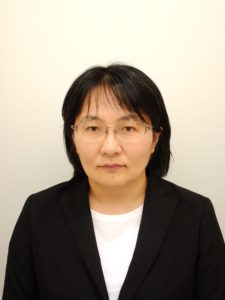Journal of Materials Chemistry B and Materials Advances are delighted to welcome Professor Yoshiko Miura from Kyushu University in Japan to the Editorial Boards as a new Associate Editor.
Yoshiko Miura is currently a Professor in Chemical Engineering and Polymer Chemistry at Kyushu University, Japan. She studied polymer chemistry and biopolymer chemistry at Kyoto University under the supervision of Prof. Yukio Imanishi and Prof. Shiro Kobayashi, and received her PhD in 2000. From 2000 to 2001, she spent her postdoctoral period at the University of Pennsylvania in Professor Virgil Percec’s group. In 2001, she then returned to Japan and was appointed as an Assistant Professor in the Department of Biotechnology at Nagoya University. Then in 2005, she was appointed as an Associate Professor at the School of Materials Science in the Japan Advanced Institute of Technology. From 2010 to the present, she is a Professor at Kyushu University. Her current research interests include the development of bio-based polymers of glycopolymers, biofunctional nanogels, porous polymers, and biomimetic materials.
Check out some of Yoshiko Miura’s recent publications in RSC journals:
A QCM study of strong carbohydrate–carbohydrate interactions of glycopolymers carrying mannosides on substrates
Takahiro Oh, Takeshi Uemura, Masanori Nagao, Yu Hoshino and Yoshiko Miura
J. Mater. Chem. B, 2022, 10, 2597-2601, DOI: 10.1039/D1TB02344F
Controlled polymerization for the development of bioconjugate polymers and materials
Yoshiko Miura
J. Mater. Chem. B, 2020, 8, 2010-2019, DOI: 10.1039/C9TB02418B
Controlling the block sequence of multi-block oligomer ligands for neutralization of a target peptide
Hinata Takimoto, Sho Katakami, Yoshiko Miura and Yu Hoshino
Mater. Adv., 2020, 1, 604-608, DOI: 10.1039/D0MA00149J
Screening of a glycopolymer library for GM1 mimetics synthesized by the “carbohydrate module method”
Masanori Nagao, Takeshi Uemura, Tasuku Horiuchi, Yu Hoshino and Yoshiko Miura
Chem. Commun., 2021, 57, 10871-10874, DOI: 10.1039/D1CC04394C
Read our interview below to find out more about Yoshiko:
1. What attracted you to pursue a career in materials science and how did you get to where you are now?
I chose a career in materials chemistry because of using chemistry to contribute to industry, human resource development, and biotechnology. Since polymer chemistry was my original major, I built my career by conducting functional materials research that incorporated cutting-edge polymer chemistry. I belonged not only to the Department of Chemistry but also to Biotechnology, Materials Science, and Chemical Engineering to learn not only the peripheral materials chemistry but also the peripheral research areas, which helped me in my career development.
2. Why did you choose to specialize in your specific research field?
I specialized in polymeric materials because of the many contributions that can be made by materials chemistry, especially polymer functional materials. In particular, I am interested in glycopolymers because they make use of natural substances. Glycopolymers are attractive to me because they are a fusion of synthetic chemistry, polymer chemistry, and biotechnology, and are interesting materials.
3. What excites you most about your area of research and what has been the most exciting moment of your career so far?
It is very exciting to see advances in materials chemistry as new research methods are invented that one might not have thought of. Also, in my own research, it is very exciting to see a molecule that I have designed function as it should.
4. What has been the most challenging moment of your career so far?
After I became independent as a PI shortly, I could not get scientific research grants, which made it difficult for my own research to survive.
5. What is your favourite reaction or material, and why?
That is RAFT living radical polymerization. It is a relatively easy chemical reaction to achieve, and at the same time, the reaction is highly versatile.
6. Why do you feel that researchers should choose to publish their work in Journal of Materials Chemistry B and Materials Advances?
The two journals, Journal of Materials Chemistry B and Materials Advances, have a wide range of expertise editors in materials chemistry, which ensures that the journals are properly reviewed. The journals are properly managed, and their impact factors are stable.
7. What attracted you to join the Editorial Boards of Journal of Materials Chemistry B and Materials Advances?
These two journals are among the top journals in materials chemistry and are journals to which I make my own submissions. It is an honour and at the same time a very rewarding job to be able to personally contribute to the management of a journal that is at the center of materials chemistry, with a focus on bio-applications.
8. The JMC and Materials Advances teams are delighted to welcome you to the Editorial Board. What are you most looking forward to when acting as Associate Editor for the journals?
As Associate Editor, I am most looking forward to learning about the latest developments in materials chemistry and to working on activities that will enhance the importance of materials chemistry.
9. Why should young people study chemistry or related subjects?
Chemistry and materials are involved in environmental issues, health care, and all matters. By studying chemistry, students can develop the ability to understand and solve the various problems of today’s world based on chemistry.
10. What impact do you feel that your area of research can make over the next 10 years?
Many biofunctional materials have been published and some research is superior to the current technologies. Practical application of some excellent studies will contribute to the development of basic science and medicine as a result of biotechnology.
Submit your best work to Yoshiko and our team of Associate Editors on Journal of Materials Chemistry B and Materials Advances now! Check out our author guidelines for information on our article types or find out more about the advantages of publishing in a Royal Society of Chemistry journal.
Keep up to date with our latest articles, reviews, collections & more by following us on Twitter, Facebook or by signing up to our E-Alerts.











